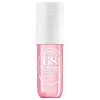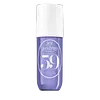What's inside
What's inside
 Key Ingredients
Key Ingredients

No key ingredients
 Benefits
Benefits

No benefits
 Concerns
Concerns

 Ingredients Side-by-side
Ingredients Side-by-side

Water
Skin ConditioningCetearyl Alcohol
EmollientParfum
MaskingCaprylic/Capric Triglyceride
MaskingIsopentyldiol
HumectantGlyceryl Stearate
EmollientC13-16 Isoparaffin
SolventGlycerin
HumectantPyrus Malus Fruit Extract
Skin ConditioningCetyl Alcohol
EmollientCocos Nucifera Oil
MaskingCaryodendron Orinocense Seed Oil
EmollientButyrospermum Parkii Butter
Skin ConditioningBehenyl Alcohol
EmollientSqualane
EmollientCollagen Amino Acids
MoisturisingTheobroma Grandiflorum Seed Butter
Skin ConditioningCopaifera Officinalis Resin
MaskingAstrocaryum Vulgare Kernel Oil
Skin ConditioningAstrocaryum Murumuru Seed Butter
EmollientDaucus Carota Sativa Root Extract
Skin ConditioningTocopherol
AntioxidantOryza Sativa Bran Extract
Skin ConditioningRosmarinus Officinalis Leaf Extract
AntimicrobialHelianthus Annuus Seed Oil
EmollientHelianthus Annuus Extract
EmollientEthylhexylglycerin
Skin ConditioningPentylene Glycol
Skin ConditioningHeptyl Undecylenate
EmollientPotassium Cetyl Phosphate
EmulsifyingTetrasodium Glutamate Diacetate
Xanthan Gum
EmulsifyingCitric Acid
BufferingSodium Hydroxide
BufferingPhenoxyethanol
PreservativeMica
Cosmetic ColorantAlpha-Isomethyl Ionone
PerfumingBenzyl Salicylate
PerfumingCI 77891
Cosmetic ColorantWater, Cetearyl Alcohol, Parfum, Caprylic/Capric Triglyceride, Isopentyldiol, Glyceryl Stearate, C13-16 Isoparaffin, Glycerin, Pyrus Malus Fruit Extract, Cetyl Alcohol, Cocos Nucifera Oil, Caryodendron Orinocense Seed Oil, Butyrospermum Parkii Butter, Behenyl Alcohol, Squalane, Collagen Amino Acids, Theobroma Grandiflorum Seed Butter, Copaifera Officinalis Resin, Astrocaryum Vulgare Kernel Oil, Astrocaryum Murumuru Seed Butter, Daucus Carota Sativa Root Extract, Tocopherol, Oryza Sativa Bran Extract, Rosmarinus Officinalis Leaf Extract, Helianthus Annuus Seed Oil, Helianthus Annuus Extract, Ethylhexylglycerin, Pentylene Glycol, Heptyl Undecylenate, Potassium Cetyl Phosphate, Tetrasodium Glutamate Diacetate, Xanthan Gum, Citric Acid, Sodium Hydroxide, Phenoxyethanol, Mica, Alpha-Isomethyl Ionone, Benzyl Salicylate, CI 77891
 Reviews
Reviews

Alternatives
Ingredients Explained
These ingredients are found in both products.
Ingredients higher up in an ingredient list are typically present in a larger amount.
Alpha-Isomethyl Ionone is a fragrance. It can be synthetically created or naturally occurring.
The scent of Alpha-Isomethyl Ionone is described as "flowery" but can also be "woody".
Naturally occurring Alpha-Isomethyl Ionone may be found in Saccharomyces cerevisiae, or the yeast used to make wine and bread.
The term 'fragrance' is not regulated in many countries. In many cases, it is up to the brand to define this term. For instance, many brands choose to label themselves as "fragrance-free" because they are not using synthetic fragrances. However, their products may still contain ingredients such as essential oils that are considered a fragrance.
Learn more about Alpha-Isomethyl IononeParfum is a catch-all term for an ingredient or more that is used to give a scent to products.
Also called "fragrance", this ingredient can be a blend of hundreds of chemicals or plant oils. This means every product with "fragrance" or "parfum" in the ingredients list is a different mixture.
For instance, Habanolide is a proprietary trade name for a specific aroma chemical. When used as a fragrance ingredient in cosmetics, most aroma chemicals fall under the broad labeling category of “FRAGRANCE” or “PARFUM” according to EU and US regulations.
The term 'parfum' or 'fragrance' is not regulated in many countries. In many cases, it is up to the brand to define this term.
For instance, many brands choose to label themselves as "fragrance-free" because they are not using synthetic fragrances. However, their products may still contain ingredients such as essential oils that are considered a fragrance by INCI standards.
One example is Calendula flower extract. Calendula is an essential oil that still imparts a scent or 'fragrance'.
Depending on the blend, the ingredients in the mixture can cause allergies and sensitivities on the skin. Some ingredients that are known EU allergens include linalool and citronellol.
Parfum can also be used to mask or cover an unpleasant scent.
The bottom line is: not all fragrances/parfum/ingredients are created equally. If you are worried about fragrances, we recommend taking a closer look at an ingredient. And of course, we always recommend speaking with a professional.
Learn more about ParfumWater. It's the most common cosmetic ingredient of all. You'll usually see it at the top of ingredient lists, meaning that it makes up the largest part of the product.
So why is it so popular? Water most often acts as a solvent - this means that it helps dissolve other ingredients into the formulation.
You'll also recognize water as that liquid we all need to stay alive. If you see this, drink a glass of water. Stay hydrated!
Learn more about Water